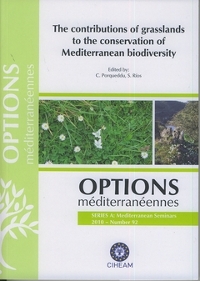| Article précédent | p. 237-240 | Article suivant |
Study of the evolution of the floristic diversity in areas of pasturage in Titaguas and Tuéjar (Valencia, Spain)
In several zones of the Mediterranean area grazing is used to contribute to the control of the vegetation with an objective of prevention of fires. This study tries to evaluate the influence of grazing on the evolution of the floristic diversity in cleared bushes and submitted to this process. The effects of the grazing produced by goats were studied in an area that had been mechanically cleared. The study extended for a period of four years and included communities of bushes dominated by Quercus coccifera, Thymus vulgaris and Rosmarinus officinalis (Rhamno lycioidis-Quercion cocciferae). The floristic diversity was calculated by means of the indexes of Shannon in grazed zones and control zones (fenced, not grazed). The first samplings were carried out in the years 2006 and 2009. With regard to the evolution in the time, during the first year the specific diversity did not change significantly after the grazing, but after three years the registered specific diversity was higher in the grazed plots. The Shannon's index values obtained are similar for the relative frequency of species. Nevertheless there have been changes in the catalogue having slightly increased the number of taxa, some have not appeared and others have appeared.
Dans la région méditerranéenne, le pâturage est souvent utilisé pour participer au contrôle de la végétation et prévenir les incendies. Cette étude vise à déterminer l'influence du pâturage sur l'évolution de la diversité de la flore dans des maquis débroussaillés par des caprins sur une période de quatre ans dans des communautés de buissons dominées par Quercus coccifera, Thymus vulgaris et Rosmarinus officinalis (Rhamno lycioidis-Quercion cocciferae). La diversité a été déterminée par l'index de diversité de Shannon dans des zones de pâturage et des zones de contrôle (clôturé, non pâturé). Les premiers échantillonnages ont été réalisés en 2006 et 2009. Par rapport à l'évolution dans le temps, la richesse spécifique de la première année n'a pas varié de façon significative par l'activité du bétail, mais trois ans plus tard, cette richesse spécifique est plus élevée dans les parcelles pâturées. Les valeurs obtenues pour l'index de Shannon sont similaires à celles de la fréquence relative des espèces. Néanmoins des changements dans le catalogue sont apparus, le nombre de taxons ayant légèrement augmenté avec l'apparition de certains taxons et d'autres pas.
- [ Afficher ]
- [ Télécharger ]
- [ Exporter la citation ]
Vous pouvez télécharger la citation au format :
- [ Imprimer ]
-
Mots-clés
BIODIVERSITE, COMPOSITION BOTANIQUE, ESPAGNE, FLORE, PATURAGE, VARIETECiter cet article
Donat M.P., Dopazo C., Cabrelles V., Herreros M.J., Segura G. Study of the evolution of the floristic diversity in areas of pasturage in Titaguas and Tuéjar (Valencia, Spain). In : Porqueddu C. (ed.), Ríos S. (ed.). The contributions of grasslands to the conservation of Mediterranean biodiversity. Zaragoza : CIHEAM / CIBIO / FAO / SEEP, 2010. p. 237-240. (Options Méditerranéennes : Série A. Séminaires Méditerranéens; n. 92). 13. Meeting of the Sub-Network on Mediterranean Forage Resources of the FAO-CIHEAM International Network for the Research and Development of Pasture and Forage Crops, 2010/04/07-10, Alicante (Spain). http://om.ciheam.org/om/pdf/a92/00801248.pdf



